The 2012 MacBook Air (11 & 13-inch) Review
by Anand Lal Shimpi on July 16, 2012 12:53 PM EST- Posted in
- Apple
- Mac
- MacBook Air
- Laptops
- Notebooks
The More Complicated (yet predictable) SSD Lottery
Apple continues to use a custom form factor and interface for the SSDs in the MacBook Air. This generation Apple opted for a new connector, so you can't swap drives between 2011 and 2012 models. I'd always heard reports of issues with the old connector from a manufacturing standpoint, so the change makes sense. The new SSD connector looks to be identical to the one used by the Retina Display equipped MacBook Pro, although rest of the SSD PCB is different.

The Toshiba Branded SandForce SF-2200 controller in the 2012 MacBook Air - iFixit
As always there are two SSD controller vendors populating the drives in the new MacBook Air: Toshiba and Samsung. The Samsung drives use the same PM830 controller found in the 2012 MacBook Pro as well as the MacBook Pro with Retina Display. The Toshiba drives use a rebranded SandForce SF-2200 controller. Both solutions support 6Gbps SATA and both are capable of reaching Apple's advertised 500MB/s sequential access claims.
While in the past we've recommended the Samsung over the Toshiba based drives, things are a bit more complicated this round because of the controller vendor Toshiba decided to partner with.

The write/recycle path in NAND flash based SSD
Samsung's PM830 works just like any other SSD controller. To the OS it presents itself as storage with logical block addresses starting from 0 all the way up to the full capacity of the drive. Reads and writes come in at specific addresses, and the controller maps those addresses to blocks and pages in its array of NAND flash. Every write that comes in results in data written to NAND. Those of you who have read our big SSD articles in the past know that NAND is written to at the page level (these days pages are 8KB in size), but can only be erased at the block level (typically 512 pages, or 4MB). This write/erase mismatch combined with the fact that each block as a finite number of program/erase cycles it can endure is what makes building a good SSD controller so difficult. In the best case scenario, the PM830 will maintain a 1:1 ratio of what the OS tells it to write to NAND and what it actually ends up writing. In the event that the controller needs to erase and re-write a block to optimally place data, it will actually end up writing more to NAND than the OS requested of it. This is referred to as write amplification, and is responsible for the performance degradation over time that you may have heard of when it comes to SSDs.
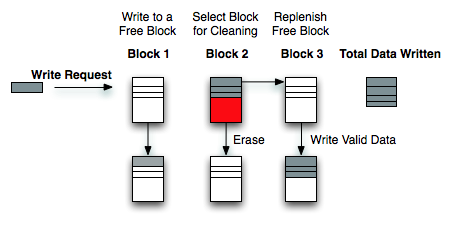
Write Amplification
For most client workloads, with sufficient free space on your drive, Samsung's PM830 can keep write amplification reasonably low. If you fill the drive and/or throw a fragmented enough workload at it, the PM830 doesn't actually behave all that gracefully. Very few controllers do, but the PM830 isn't one of the best in this regard. My only advice is to try and keep around 20% of your drive free at all times. You can get by with less if you are mostly reading from your drive or if most of your writes are just big sequential blocks (e.g. copying big movies around). I explain the relationship between free space and write amplification here.

Write Amplification vs. Spare Area, courtesy of IBM Zurich Research Laboratory
The Toshiba controller works a bit different. As I already mentioned, Toshiba's controller is actually a rebranded SandForce controller. SandForce's claim to fame is the ability to commit less data to NAND than your OS writes to the drive. The controller achieves this by using a hardware accelerated compression/data de-duplication engine that sees everything in the IO stream.
The drive still presents itself as traditional storage with an array of logical block addresses. The controller still keeps track of mapping LBAs to NAND pages and blocks. However, because of the compression/dedupe engine, not all data that's written to the controller is actually written to NAND. Anything that's compressible, is compressed before being written. It's decompressed on the fly when it's read back. All of the data is still tracked, the drive still is and appears to be the capacity that is advertised (you don't get any extra space), you just get extra performance. After all, writing nothing is always faster than writing something.
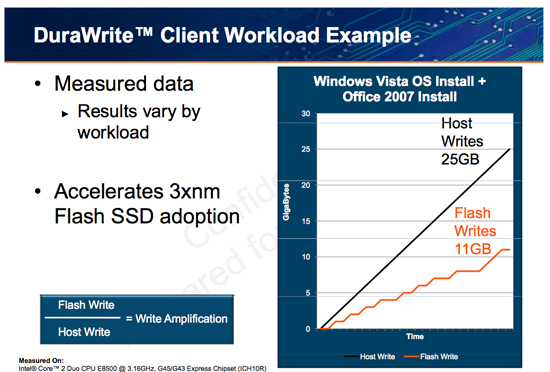
Writing less data to NAND can improve performance over time by keeping write amplification low. There are also impacts on NAND endurance, but as I've shown in the past, endurance isn't a concern for client drives and usage models. Writing less also results in a slight reduction in component count: there's no external DRAM found on SandForce based drives. The PM830 SSD features a 256MB DDR2 device on-board, while the Toshiba based drive has nothing - just NAND and the controller. This doesn't end up making the Toshiba drive substantially cheaper as SandForce instead charges a premium for its controller. In the case of the PM830, both user data and LBA-to-NAND mapping tables are cached in DRAM. In the case of the Toshiba drive, a smaller on-chip cache is used since there's typically less data being written to the NAND itself.
SandForce's approach is also unique in that performance varies depending on the composition of the data written to the drive.
PC users should be well familiar with SandForce's limitations, but this is the first time that Apple has officially supported the controller under OS X. As such I thought I'd highlight some of the limitations so everyone knows exactly what they're getting into.
Any data that's random in composition, or already heavily compressed, isn't further reduced by Toshiba's SandForce controller. As SandForce's architecture is designed around the assumption that most of what we interact with is easily compressible, when a SF controller encounters data that can't be compressed it performs a lot slower.
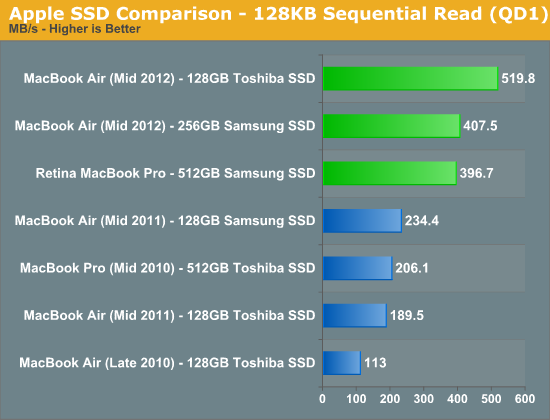
Special thanks to AnandTech reader KPOM for providing the 256GB Samsung results
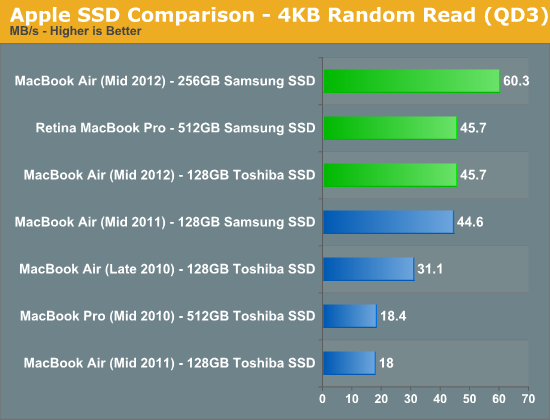
The performance impact is pretty much limited to writing. We typically use Iometer to measure IO performance as it's an incredibly powerful tool. You can define transfer size, transfer locality (from purely sequential all the way to purely random) and even limit your tests to specific portions of the drive, among other features. Later versions of Iometer introduced the ability to customize the composition of each IO transfer. For simplicity, whenever Iometer goes to write anything to disk it's a series of repeating bytes (all 0s, all 1s, etc...). Prior to SandForce based SSDs this didn't really matter. SandForce's engine will reduce these IOs to their simplest form. A series of repeating bytes can easily be represented in a smaller form (one byte and a record of how many times it repeats). Left at its default settings, SandForce drives look amazing in Iometer - even faster than the PM830 based Samsung drive that Apple uses. Even more impressive, since very little data is actually being written to the drive, you can run default Iometer workloads for hours (if not days) on end without any degradation in performance. Doing so only tells us part of the story. While frequently used OS and application files are easily compressed, most files aren't.
Thankfully, later versions of Iometer include the ability to use random data in each transfer. There's still room for some further compression or deduplication, but it's significantly reduced. In the write speed charts below you'll see two bars for the Toshiba based SSD, the one marked incompressible uses Iometer's random data setting, the other one uses the default write pattern.
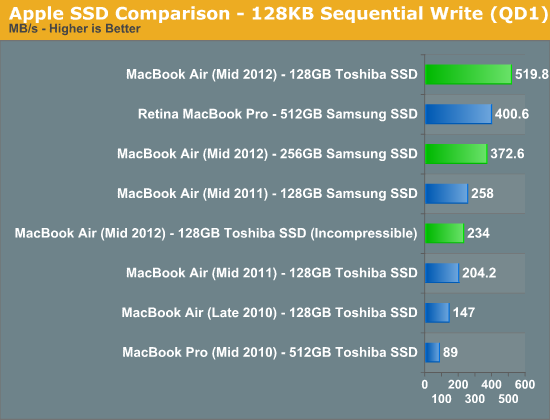
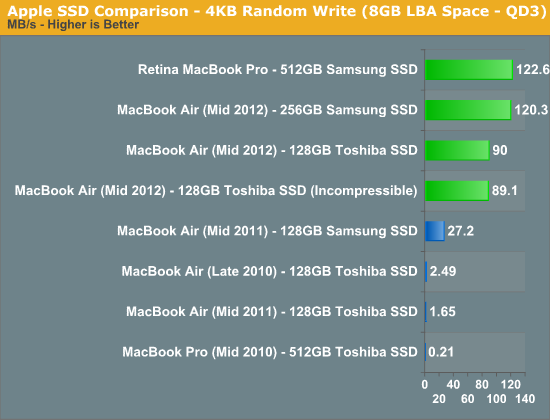
When fed easily compressible data, the Toshiba/SandForce SSD performs insanely well. Even at low queue depths it's able to hit Apple's advertised "up-to" performance spec of 500MB/s. Random write performance isn't actually as good as Samsung's, but it's more likely to maintain these performance levels over time.
Therein lies the primary motivator behind SandForce's approach to flash controller architecture. Large sequential transfers are more likely to be heavily compressed (e.g. movies, music, photos), while the small, pseudo-random accesses are more likely easily compressible. The former is rather easy for a SSD controller to write at high speeds. Break up the large transfer, stripe it across all available NAND die, write as quickly as possible. The mapping from logical block addresses to pages in NAND flash is also incredibly simple. Fewer entries are needed in mapping tables, making the read and write of these large files incredibly easy to track/manage. It's the small, pseudo-random operations that cause problems. The controller has to combine a bunch of unrelated IOs in order to get good performance, which unfortunately leaves the array of flash in a highly fragmented state - bringing performance down for future IO operations. If SandForce's compression can reduce the number of these small IOs (which it manages to do very well in practice), then the burden really shifts to dealing with large sequential transfers - something even the worst controllers can do well.
It's really a very clever technology, one that has been unfortunately marred by a bunch of really bad firmware problems (mostly limited to PCs it seems).
The downside in practice is the performance when faced with these incompressible workloads. Our 4KB random write test doesn't actually drop in performance, but if we ran it for long enough you'd see a significant decrease in performance. The sequential write test however shows an immediate reduction of more than half. If you've been wondering why your Toshiba SSD benchmarks slower than someone else's Samsung, check to see what sort of data the benchmark tool is writing to the drive. The good news is that even in this state the Toshiba drive is faster than the previous generation Apple SSDs, the bad news is the new Samsung based drive is significantly quicker.
What about in the real world? I popped two SSDs into a Promise Pegasus R6, created a RAID-0 array, and threw a 1080p transcode of the Bad Boys Blu-ray disc on the drive. I then timed how long it took to copy the movie to the Toshiba and Samsung drives over Thunderbolt:
| Real World SSD Performance with Incompressible Data | ||||
| Copy 13870MB H.264 Movie | 128GB Toshiba SSD | 512GB Samsung SSD | ||
| Transfer Time | 59.97 s | 31.59 s | ||
| Average Transfer Rate | 231.3 MB/s | 439.1 MB/s | ||
The results almost perfectly mirrored what Iometer's incompressible tests showed us (which is why I use those tests so often, they do a good job of modeling the real world). The Samsung based Apple SSD is able to complete the file copy in about half the time of the Toshiba drive. Pretty much any video you'd have on your machine will be heavily compressed, and as a result will deliver the worst case performance on the Toshiba drive.
Keep in mind that to really show this difference I had to have a very, very fast source for the transfer. Unless you've got a 6Gbps SSD over USB 3.0 or Thunderbolt, or a bunch of hard drives you're copying from, you won't see this gap. The difference is also less pronounced if you're copying from and to the same drive. Whether or not this matters to you really depends on how often you move these large compressed files around. If you do a lot of video and photo work with your Mac, it's something to pay attention to.
There's another category of users who will want to be aware of what you're getting into with the Toshiba based drive: anyone who uses FileVault or other full disk encryption software.
Remember, SandForce's technology only works on files that are easily compressed. Good encryption should make every location on your drive look like a random mess, which wreaks havoc on SandForce's technology. With FileVault enabled, all transfers look incompressible - even those small file writes that I mentioned are usually quite compressible earlier.
After enabling FileVault I ran our Iometer write tests on the drives again, performance is understandably impacted:
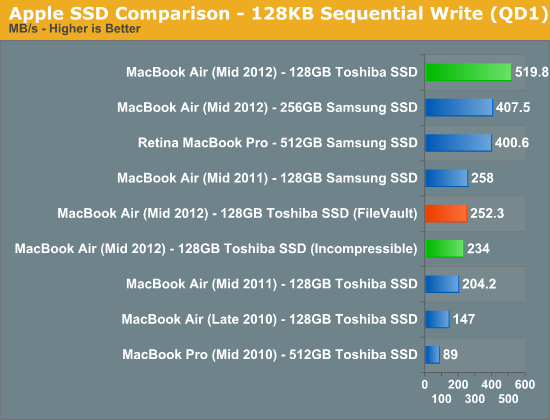
Also look at what happens to our 4KB random write test if we repeat it a few times back to back:
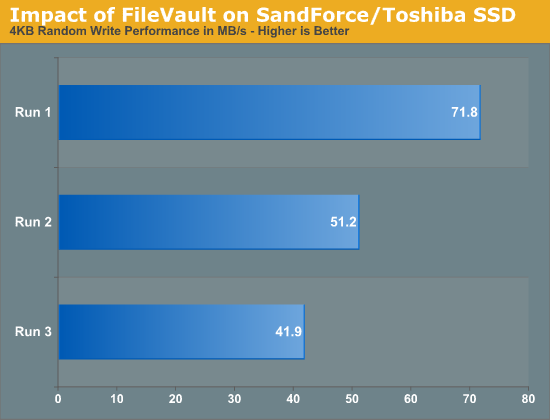
That trend will continue until the drive's random write performance is really bad. Sequential write passes will restore performance up to ~250MB/s, but it takes several passes to get it there:
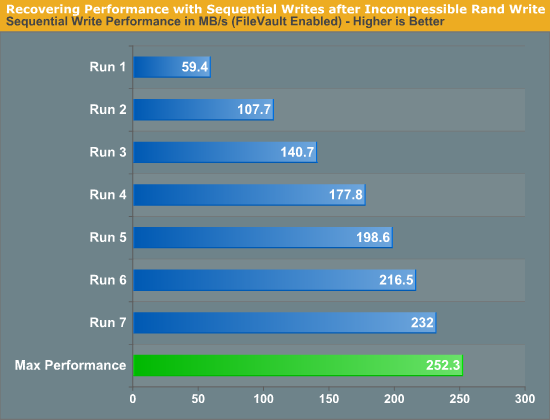
If you're going to be using FileVault, stay away from the Toshiba drive.
This brings us to the next problem: how do you tell what drive you have?
As of now Apple has two suppliers for the SSD controllers in all of its 2012 Macs: Toshiba and Samsung. If you run System Information (click the Apple icon in the upper left > About this Mac > System Report) and select Serial ATA you'll see the model of your SSD. Drives that use Toshiba's 6Gbps controller are labeled Apple SSD TSxxxE (where xxx is your capacity, e.g. TS128E for a 128GB drive), while 6Gbps Samsung drives are labeled Apple SSD SMxxxE. Unfortunately this requires you to already purchase and open up your system. It's a good thing that Apple stores are good about accepting returns.
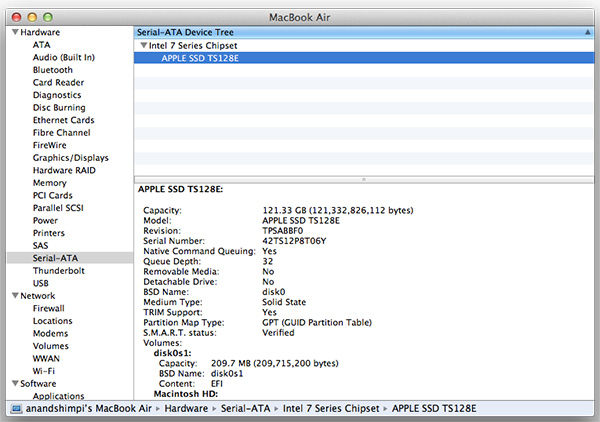
There's another option that seems to work, for now at least. It seems as if all 256GB and 512GB Apple SSDs currently use Samsung controllers, while Toshiba is limited to the 64GB and 128GB capacities. There's no telling if this trend will hold indefinitely (even now it's not a guarantee) but if you want a better chance of ending up with a Samsung based drive, seek out a 256GB or larger capacity. Note that this also means that the rMBP exclusively uses Samsung controllers, at least for now.
I can't really blame Toshiba for this as even Intel has resorted to licensing SandForce's controllers for its highest performing drives. I will say that Apple doesn't seem to be fond of inconsistent user experiences across its lineup. I wouldn't be surprised if Apple sought out a third SSD vendor at some point.










190 Comments
View All Comments
robco - Wednesday, July 18, 2012 - link
I have a few friends who upgraded to the new Airs and love them. I'm holding onto my 3 year old MBP for another year until Haswell comes out. Though it looks like the HD 4000 can keep up with or even surpass the 9600M in mine.I'm leaning toward the Air, though my personal prediction (hope?) is that when Haswell comes out next year, that will have enough oomph for Apple to launch the 13" rMBP with a 2560x1600 display. If they can keep the weight under 4 lbs., that would be awesome.
As for Apple not being the first, being first isn't always best. There were other ultraportables before the 2010 Air, but few sold in large volume. There were tablets before the iPad, but relatively few sales. There were smartphones before the iPhone, but few consumers wanted them. Being first isn't important, executing a good product is.
And for the anecdotal stories, how a company handles a problem is also quite important. I'm on my second Apple laptop, but each one has had issues (I get AppleCare). On my 2006 MB, the trim started pulling away, made an appointment at the Apple Store, they replaced the top case the same day. A week before AppleCare expired, I noticed the optical drive had failed (never really used it), they not only replaced it, but found that one of the cooling fans wasn't operating quite as fast as it should, they replaced that too. When I got my 2009 MBP, the trackpad started sticking and wouldn't click, fixed same day. I got a battery error, that was replaced in about 20 mins. No waiting on hold for hours, going through a bunch of repetitive nonsense. Fixed quickly, no questions asked. I don't expect to never have an issue, I'm hardly gentle with my laptops, but when something does happen, it's nice to know things get fixed quickly without a lot of hassle. Then again, that's just my own personal experience...
MobiusStrip - Wednesday, July 18, 2012 - link
Yay, more Apple computers with mandatory, shitty glossy screens.What kind of "leader" takes its cues from the third-tier plastic schlock being peddled at Best Buy? Glossy screens are the biggest regression in computing ever. Absolutely moronic.
Deepcover96 - Wednesday, July 18, 2012 - link
I hadn't noticed that my 2012 MacBook Air's screen was glossy. Maybe they made it less glossy?phillyry - Tuesday, March 26, 2013 - link
Maybe they made them extra glossy on purpose so that we wouldn't be able to notice the terrible viewing angles for all the glare!phillyry - Thursday, March 28, 2013 - link
Also helps to hide the pixelation.Lepton87 - Wednesday, July 18, 2012 - link
I have something to say regarding anand's conclusion that 1920x1200 on a 11' is a stopgap solution and apple is too great to settle for something so mediocre. 2732x1536 on the 11.6 is totally idiotic. You don't need more than 120PPI on a desktop and 140PPI on a laptop for a screen to be considered retina.(remember viewing distance is a big factor) So why waste all that processing power? Even retina Macbook pro can't render everything silky smooth. Even my 2560x1440 desktop 27'' "lowly" resolution screen is 90% retina, taking into account my less than perfect eyesight into equation it's probably very close all that I need to not seen individual pixels from normal viewing distance. 2880x1800 on 27' would make it a perfect screen for my, everthing more than that would choke my already outdated quadfire 2x6990 CF set-up. The boss probably won't honor me with answering this personally :( I would really like to know his view on increasing resolution way past what would be considered retina, i.e making pixels much smaller than the necessary size for them to be not discernible individually from normal viewing distance.Znarkus - Thursday, July 19, 2012 - link
It would've been awesome to compare max power draw and surface temperature with the different CPUs, especially the i7 :)Alameda - Saturday, July 21, 2012 - link
I have a 2011 MacBook Air. I think the big improvement in 2012 is USB 3. Time Machine backups take a very long time (I backup once every few days). USB 3 would clearly make a big difference here. Thunderbolt, sadly, is too expensive to justify, unless you're backing up to a RAID or some such.Galatian - Sunday, July 22, 2012 - link
Hey Anand,I have yet to get back to you again concerning the Gaming Performance on the i5 ULV with HD4000. I was coming from a 2008 Unibody MacBook Pro (2,53 GHz, 8 GB RAM, Vertex 2, nVidia 9600M 512 MB vRAM), so I naturally expected that Civilization V would not run as fast on my new MacBook Air under Windows than it did on my old MacBook Pro. At least your charts suggest so. According to FRAPS I would get around 22 fps, which is not stellar but enough for turn based strategy game.
I don't know if there has been any update on the driver or what, but Civilization V is actually more playable on my MacBook Air then on my old MacBook Pro. The CPU of course is faster. My MacBook Pro would overheat and hence the Core 2 Duo only ran with like 2,0 GHz while playing the game, while the Ivy Bridge ULV actually still has enough headroom to Turbo Boost. The big surprise to me was actually the graphic performance, which has been much smoother. For the sake of it I would really like to know how you get your extremely low fps while testing Civilization V? Are you running the newest version w/o Gods & Kings add-on? Do other persons have the same experience? I thought I would make a step back in gaming performance when I switched to the MacBook Air, but to my surprise this isn't the case. I sure would like other people to know this, so they can put the Ivy Bridge ULV in better perspective.
Along the line I would really like to see a comparison between AMDs and Intels ULV offerings. The tests I see only only compare the A10 (which has a much higher TDP) to Intels ULV platform. From my understanding only the Bobcat should be comparable to Intels ULV offering. Then again I really can't follow what is what with AMD especially I don't which ones are released and which ones are not...
cookiezulu - Monday, July 30, 2012 - link
Hi Anand, thank you for yet another excellent review! I was worried for a sec there that you might be busy with other things and skip the review for the MBA this year.The MBA 2012 (8GB, stock processor) is my first ever MAC and also my first computer with an SSD drive. I'm not very familiar with how the SD Card slots work in these SSD machines and/or in Mac machines and I would like to buy one of these:
http://www.kickstarter.com/projects/1342319572/the...
It's essential a microSD card holder that sits flush with the MBA (rather than sticking out). I held out because of the issue of the SD card preventing the computer from going into deep sleep mode, as per Apple support article here:
https://support.apple.com/kb/HT4392
Somebody then thought to ask what happens if the SD/microSD card is left in place but it is unmounted on a software level. In theory this should allow the Macs to go into deep sleep (standby) mode as the SD card slot would be just as 'dead' as if the card wasn't there.
I'm definitely looking to always have an SD card into the slot, both to increase storage but also, and more importantly, to use it for exactly the types of activities that you mention in the article as slowing it down. I want the SSD to run just operating system and installed programs. All others (downloads, music, photo, etc) I want to keep on external devices.
Can you, by any chance, offer any help/info/clarification on this one?
Thanks ever so much